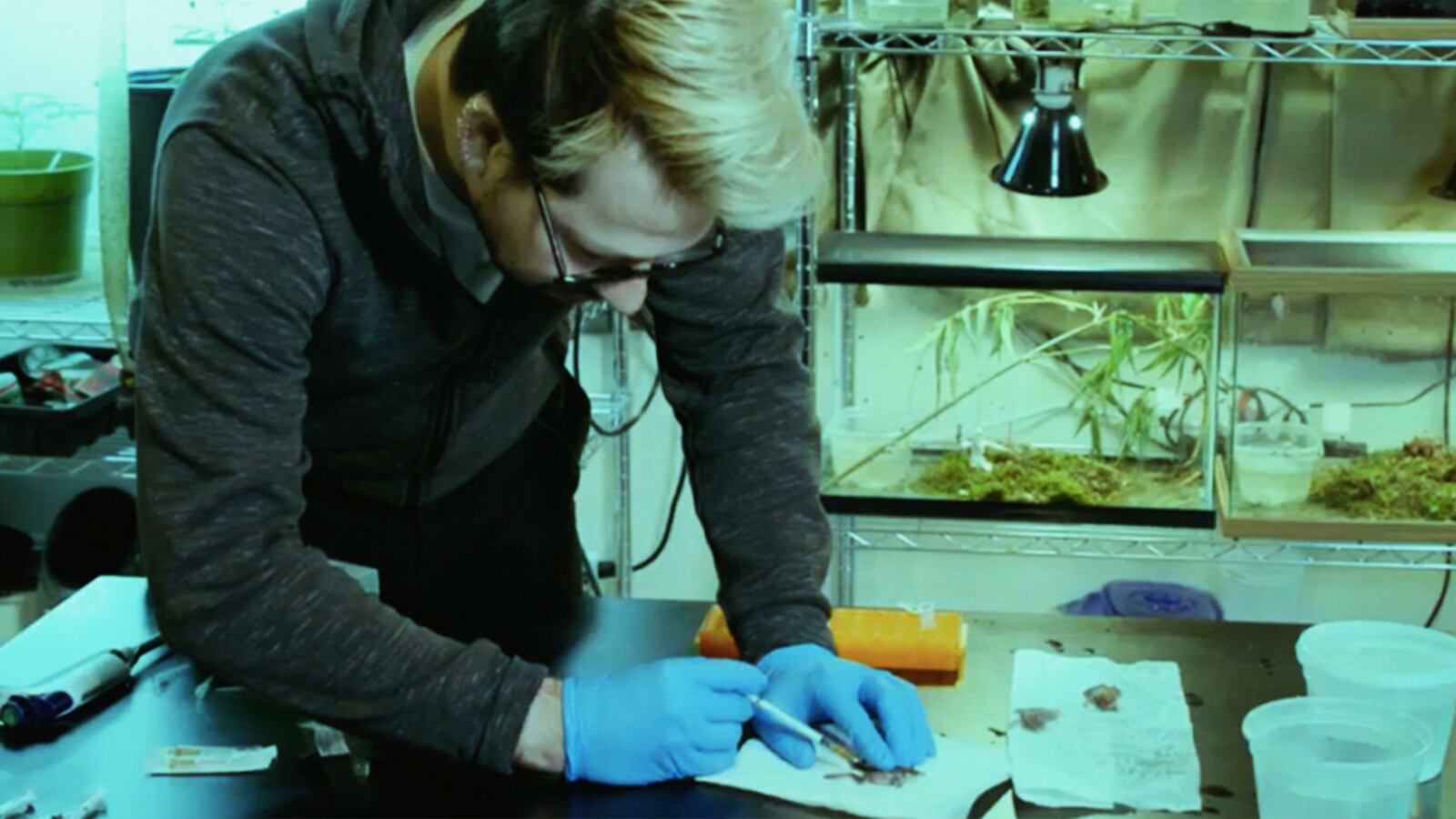When one thinks about scientific study, the images that spring to mind generally involve studious men and women in lab coats performing careful research in sterile environments. Those notions don’t pertain to biohackers, however, who carry out cutting-edge—and often legally and morally dubious—DIY experiments on themselves and others in the name of pushing the boundaries of what’s technologically possible. They’re punk rock dreamers dedicated to figuring out tomorrow’s evolutionary breakthroughs and cures today.
Take, for example, Josiah Zayner, a former NASA scientist who made waves in 2017 when, on a livestream at a San Francisco biotech conference, he injected himself in the arm with the gene-editing tool CRISPR as a means of increasing the size of his muscles. Earlier this year, Zayner decided to help the American scientific community in its race for a COVID-19 cure by personally taking a potential DNA vaccine that was first discussed in a Harvard University paper, and had only been tested on monkeys. The results were underwhelming, but the attitude behind the trial was pure rebel biohacker boldness—and is emblematic of a community that views the coronavirus as an ideal opportunity to research, test, and show the world that taking scientific measures into your own hands is the key to progress.
Yet as Citizen Bio suggests, the behavior of Zayner and his ilk may do more harm than good. Director Trish Dolman’s documentary (premiering Oct. 30 on Showtime) examines this subculture via the tale of Aaron Traywick, founder of Ascendance Biomedical, an outfit designed to create affordable and readily-available treatments for a variety of ailments. Traywick attracted national media attention when, on an October 2017 Facebook livestream, his associate Tristan Roberts injected himself with an unproven HIV remedy. Traywick followed that up by pulling his own pants down and sticking himself with an experimental cocktail purported to eradicate herpes at the 2018 BDYHAX Conference. With long hair, a big smile, and seemingly prodigious financial resources, Traywick struck a pose as a charismatic pioneer, dedicated to fostering a self-improvement movement that didn’t wait for the government, or corporations, to confront issues of disease, degeneration, and aging.
Traywick’s own rise to fame, though, was short-lived. In April 2018, he was found dead at the age of 28, face-down in a sensory deprivation tank in a Washington, D.C. meditation spa—an ignominious, and mysterious, fate for an individual who ultimately made as many enemies as he did headlines.
One look at the makeshift lab set up and run by Traywick associate Gabriel Licina, and it’s easy to get the sense that Citizen Bio’s subjects are spearheading some sort of quasi-science-fiction future in which underground radicals concoct and disseminate homemade techno-innovations. As evidenced by bodyhacker Russ Foxx’s demonstration of the RDIF chip he implanted in his hand—so he can activate his motorcycle and access his private safes—it’s a community of daredevils willing to risk their own safety for the greater good. The problem is, there are more dangerous implications for their work than just their own well-being—not to mention that some of those leading this crusade aren’t exactly trustworthy.
That certainly was the case with Traywick, whose enthusiasm swayed a legion of fellow biohackers (such as Roberts, Licina, Machiavelli Davis, and Andreas Stuermer), and appears genuine in interviews filmed shortly before his death. Citizen Bio is a portrait of little-known activists sidestepping official channels in the pursuit of magical marvels. Traywick was at the forefront of this charge, and it’s apparent he was reckless at best, and driven by ulterior motives at worst. Consumed with finding a way to prolong human life, Traywick began his journey by joining forces with his lobbyist cousin Edwina Rogers, who helped him make in-roads with Washington, D.C.’s power players. Before long, he’d established Ascendancy Biomedical, which aimed to produce open-access gene therapy platforms that could be used by independent and commercial researchers alike to develop disease-management strategies, free from FDA oversight.
Traywick’s ostensible goal was to discover and manufacture one-time-use cures for widespread conditions—for example, Inovium, a fertility treatment that would exploit one’s own genetic material to allow women to give birth after menopause. It’s hard to decry those intentions, but the evidence presented here indicates that the execution of these plans was highly questionable. Despite taking their work seriously, most of the biohackers featured in Citizen Bio resemble modern-day mad scientists, mixing and matching genetic material—often through the use of retail CRISPR Kits that allow anyone to splice and dice DNA—in a manner that’s more reminiscent of beer homebrewing than Jonas Salk, whose legendary polio research is invoked as an inspiration. A hasty montage of historical scientific developments further attempts to cast these men as the latest in a long line of trailblazers, which might be more persuasive if they didn’t come across as such semi-qualified tinkerers.
Citizen Bio begins by positioning Traywick as an enigmatic figure before exposing him, unsurprisingly, as a charlatan. It wasn’t long after his BDYHAX stunt that Traywick’s closest colleagues started to doubt his commitment to biohacking and its anti-establishment, outside-the-system ethos. Their suspicions appear to have been correct; in clips from a 2018 Vice News interview, Licina and Roberts pointedly question Traywick about whether he’s really supportive of crowd-sourcing his therapies (and altruistically giving them away for free), or if he’s interested in maintaining ownership of his advances (the latter turns out to be the ostensible answer). Consequently, for all the speculation about his demise (murder theories abound, since he had plenty of Big Pharma and biohacking enemies), the notion the film leaves us with is that, having taken a disgraceful tumble from his pedestal, he took his own life.

Gabriel Licina in Citizen Bio.
Courtesy of SHOWTIMEText cards set over dark, flowing water (taken from recreations of Traywick’s body floating in the sensory deprivation tank), as well as interviews conducted in low-lit rooms, generate an atmosphere of ominous menace. Such gestures are a bit heavy-handed, but in keeping with the fact that the biohacking community is rife with peril, thanks to the ever-present prospect that these untrained individuals will, while mucking about with genetic and biological material, accidentally (or deliberately) engineer a biohazard weapon or pandemic-grade plague. To be fair, none of that has happened—yet. But Citizen Bio is most gripping when it temporarily sets aside its fascination with Traywick and focuses on the intersection of noble objectives and questionable methods that defines this little-known subculture. It’s there that the promise of revolution and disaster coexist, and the prime shortcoming of Dolman’s film is that it doesn’t investigate that fraught dynamic in more in-depth fashion.
As for Traywick, his own legacy—fond family remembrances notwithstanding—is of failure born from huckster duplicity. “A bad actor within the community who performed bad science in a terrible way,” is how journalist Alex Pearlman sums him up at film’s outset, and nothing that follows appreciably complicates or refutes that apt description.


